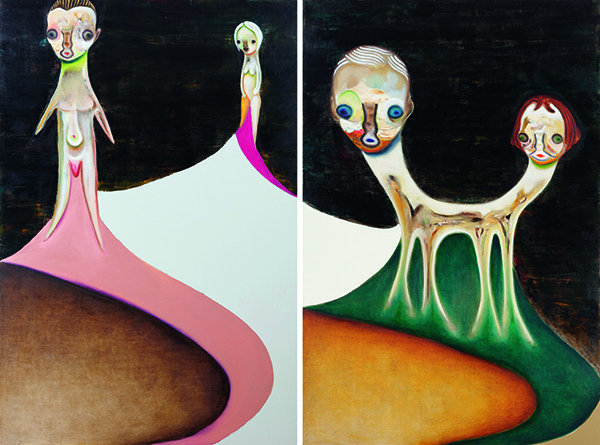
Izumi Kato’s first U.S. solo show is instantly captivating, not only because of the Japanese artist’s unusual painting methods.
His canvases are dominated by eerie yet adorable figures with dark penetrating eyes—painted not with a brush, but directly with his hands.
At the prestigious Musashino Art University in Tokyo, applicants are required to pass a test which prove their proficiency in photorealistic, formal painting techniques. Kato, now 46, graduated in 1992, but told artnet News via a translator at the opening of his show at Galerie Perrotin: “I had questions and doubts about the system.”
Installation view of Izumi Kato’s solo show at Galerie Perrotin, New York. Photo by Guillaume Ziccarelli, courtesy of the artist and Galerie Perrotin.
In an act of rebellion, he began making simplistic, childlike works on canvas at age 30. Ultimately, he did away with traditional painting implements altogether, choosing instead to work with only his hands, and occasionally a spatula.
Because he works with toxic oil paints, Kato uses latex gloves, allowing him to quickly switch between colors by removing one pair and wiggling into another set of gloves. He doesn’t begin with any specific color palette in mind, allowing the work to evolve naturally on the canvas.
Installation view of Izumi Kato’s paintings at Galerie Perrotin. Photo courtesy of the artist and Galerie Perrotin.
The scale of these paintings varies widely, with floor-to-ceiling works on the galleries first floor giving way to more intimately-sized canvases in the downstairs exhibition space. The newest works, which date only to November, are also the largest. Lately, Kato’s been working a new studio in Hong Kong, and he’s been taking advantage of the high ceilings.
Since 2003, Kato has also been working in sculpture—he “got stuck and needed some refreshment,” he said. Initially, he began working with camphor, a soft, fragrant wood commonly used in Buddhist statuary. He chose the material after seeing that Katsura Funakoshi, a highly successful sculptor, uses it.
Izumi Kato, Untitled at Galerie Perrotin. Photo by Guillaume Ziccarelli, courtesy of the artist and Galerie Perrotin.
The resulting works have a rough-hewn, ancient look. “I don’t know why,” gallery owner Emmanuel Perrotin told Artnet News at the opening, “but I see a mix of Japanese art and African art.”
In the last four years, he’s begun working in a special type of soft vinyl called sofubi, which is used by manufacturers to make big-headed Kewpie dolls and hand-painted toys.
Izumi Kato, Untitled at Galerie Perrotin. Photo by Guillaume Ziccarelli, courtesy of the artist and Galerie Perrotin.
Based on the bobble-headed figures that feature so prominently in his work, Kato created two molds from carvings done in polystyrene: a tiny body (of which he often incorporates a number into his larger wooden sculptures), and a larger head, which is cast in two pieces. (Some paintings created alongside this series, which often incorporate old loose-leaf paper, reflect this, with the figure divided at the neck, split across two separate canvases.)
The resulting work, however suggests a much greater variety of shapes. Kato sets upon each head in the manner of a mad scientist, slicing open flaps and creating incisions before surgically reconstructing it using bolts or even a needle and thread. Many feature wooden protrusions, and a few even have rough wooden skeletons. He’s even managed to morph the head into the body of a deer-human hybrid, covering the wood with translucent vinyl.
Installation view of Izumi Kato sculptures at Galerie Perrotin, New York. Photo by Guillaume Ziccarelli, courtesy of the artist and Galerie Perrotin.
“Cutting up, pasting together, and painting [a] human figure feels exactly halfway between painting and sculpture,” wrote Kato in the introduction to his 2014 monograph, Soft Vinyl Sculptures.
When artnet News asked about his process, Kato laughingly admitted to feeling more than a bit like Dr. Frankenstein. He orders about 30 heads a year from the Japanese toy manufacturer Linden, and estimates about 10 or 15 of them ever become fully-realized creations. Like any Dr. Frankenstein, Kato has his failed experiments—but unlike Mary Shelley’s title character, his success stories are undeniably lovable, even if they would be at home in a futuristic dissection lab on board an alien space craft.
Izumi Kato, Untitled at Galerie Perrotin. Photo by Guillaume Ziccarelli, courtesy of the artist and Galerie Perrotin.
Kato isn’t one to speak at length about the meaning or significance of his work, which is all untitled. “It’s open-ended,” he said, explaining that he prefers that viewers as their own personal response to the art.
That’s not to say Kato doesn’t acknowledge the dualities that are so easily seen in his work—the cute and the ugly, life and death, the masculine and the feminine. Perrotin, like the artist, is not interested in nailing down any one interpretation. “I just feel it,” he said.
See more work from the exhibition below.
Installation view of Izumi Kato’s solo show at Galerie Perrotin, New York. Photo by Guillaume Ziccarelli, courtesy of the artist and Galerie Perrotin.
Izumi Kato, Untitled at Galerie Perrotin. Photo by Guillaume Ziccarelli, courtesy of the artist and Galerie Perrotin.
Izumi Kato, Untitled at Galerie Perrotin. Photo by Guillaume Ziccarelli, courtesy of the artist and Galerie Perrotin.
Izumi Kato, Untitled at Galerie Perrotin. Photo by Guillaume Ziccarelli, courtesy of the artist and Galerie Perrotin.
Installation view of Izumi Kato’s solo show at Galerie Perrotin, New York. Photo by Guillaume Ziccarelli, courtesy of the artist and Galerie Perrotin.
“Izumi Kato” is on view at Galerie Perrotin, 909 Madison Avenue and East 73rd Street, New York, New York January 7–Feburary 27, 2016.